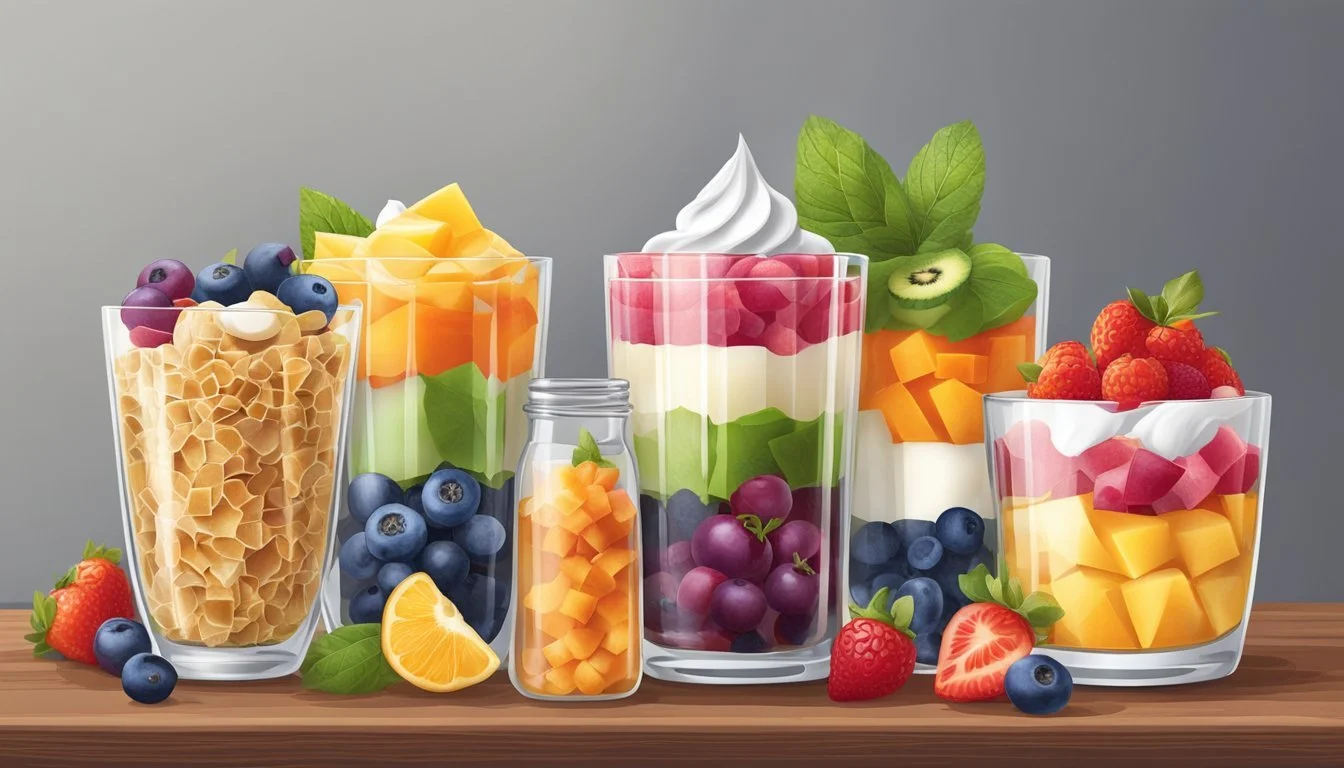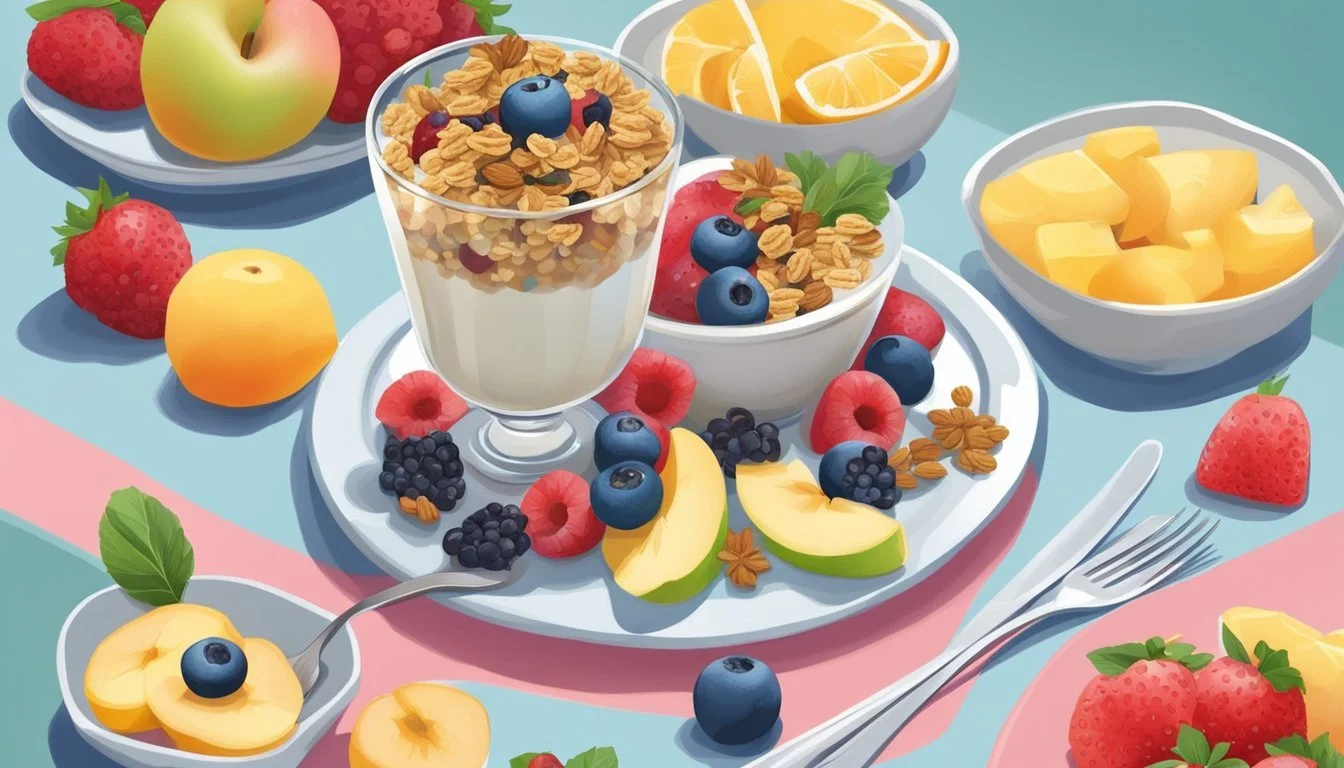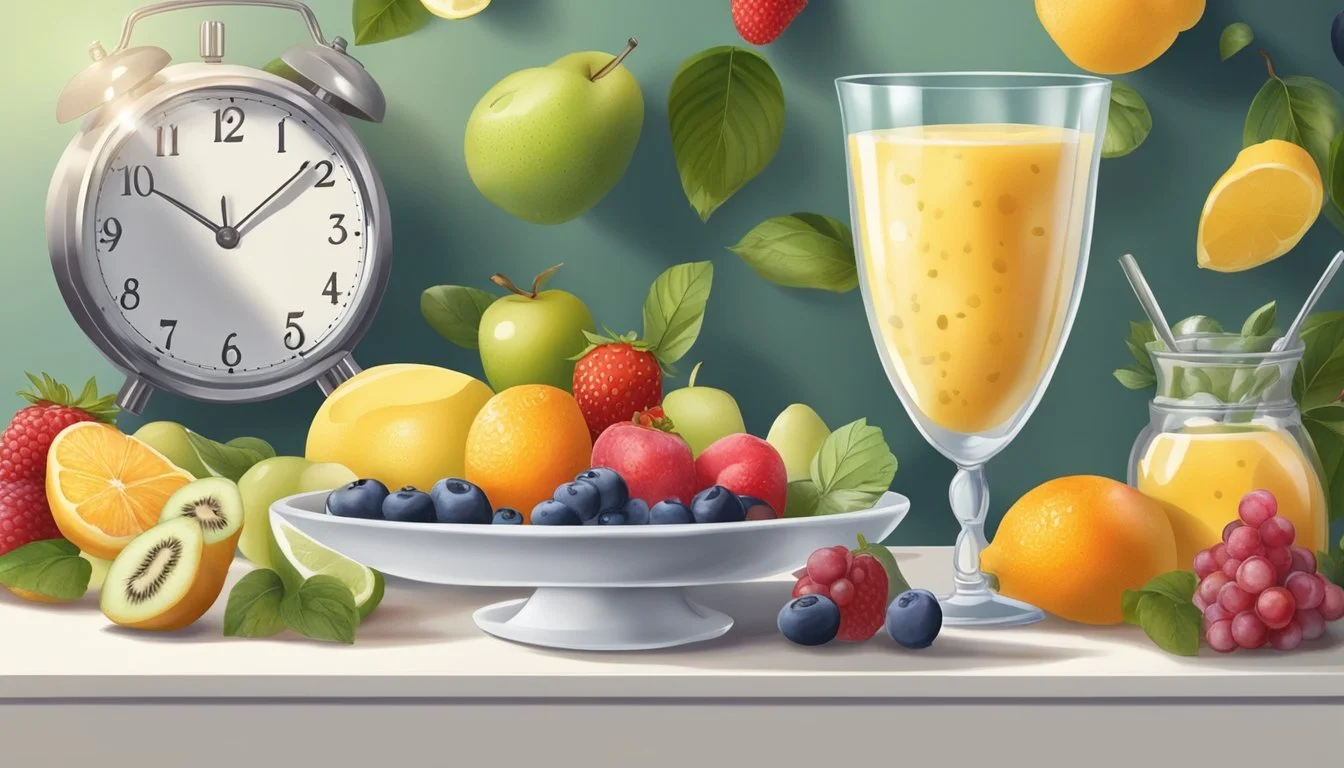How Long Do Freshly Prepared Parfaits Last?
Shelf Life and Storage Tips
Freshly prepared parfaits offer a delightful combination of textures and flavors, typically layering yogurt, fruit, and granola to create a visually appealing and nutritious treat. As with any perishable food item, the shelf life of a yogurt parfait is limited. Understanding how long these parfaits last is crucial for both food safety and optimal taste. Generally, a freshly prepared parfait can be safely stored in the refrigerator for up to 5 days, provided that it is kept in an airtight container to maintain freshness and prevent contamination.
The longevity of a parfait in the fridge largely depends on the freshness of the ingredients used and how it is assembled. To prolong the shelf life, it is recommended to prepare parfaits with fresh yogurt and thoroughly washed and dried fruits (What wine goes well with dried fruits?). As moisture can accelerate spoilage, ensuring that excess liquid is drained from fruits and layering the parfait to minimize sogginess can help maintain its quality for a longer period.
Parfaits should be consumed promptly for the best flavor and texture, as granola can become soggy and fruits may begin to release more juices over time, potentially affecting the overall consistency of the dish. For those who plan to prepare parfaits ahead of time, storing granola separately and adding it just before consumption can help preserve its crispness, thereby enhancing the enjoyment of the parfait.
Composition of a Parfait
In crafting a parfait, the selection of yogurt and fruit is crucial, not only for taste but also for the longevity of the prepared dish.
Types of Yogurt
Parfaits commonly use yogurt as their creamy base layer. Yogurt choices abound, ranging from traditional whole-fat to reduced-fat options. For those with dietary restrictions or preferences, dairy-free and plant-based yogurts, such as almond or coconut, are also popular. To balance healthfulness with indulgence, sugar content can vary, with options including no-added-sugar yogurts and those that are sweetened.
Choice of Fruit
The selection of fruit in a parfait is not only about personal preference but also about the moisture content, which can affect the dish's shelf life. Choices typically include fresh berries like strawberries, blueberries, raspberries, and blackberries. These fruits are favored for their firmness and low moisture, which prevent sogginess in the granola layers. More exotic or tropical options may include mango, pineapple, peaches, and kiwi. While frozen fruit can also be used, one should be aware that as it thaws, excess moisture can cause the granola to soften over time, potentially shortening the parfait's optimal storage duration.
Parfait Ingredients and Layering
Preparing a parfait involves carefully selecting ingredients that not only taste well together but also preserve the texture and integrity of the dish when layered. The foundation of any parfait is the strategic layering of its components, which typically include granola and nuts, dairy or a dairy substitute such as Greek or plain yogurt, and an array of sweeteners and flavorings for additional taste.
Selecting Granola and Nuts
A parfait's crunch often comes from the granola and nuts layer. For the best results, one should opt for homemade or low-moisture packaged granola to maintain its crispness within the parfait. The granola should be coarse to provide textural contrast. When incorporating nuts, options like almonds, pecans, and walnuts add both flavor and nutritional value. One can also consider bran or mini chocolate chips for extra crunch and taste. For a unique twist, seeds such as chia seeds can be included to introduce additional textures and health benefits.
Sweeteners and Flavorings
Sweeteners and flavorings enhance the depth of a parfait's flavor. Common add-ins include honey, maple syrup, or cinnamon. These ingredients should be chosen based on the desired sweetness level and compatibility with the other layers of the parfait. For a hint of tropical flavor, coconut flakes can be sprinkled in. To keep the parfait from becoming too sweet, one should use these add-ins judiciously. When selecting chocolate chips or other sweet morsels, mini chocolate chips are recommended as they distribute more evenly throughout the parfait.
Storing Parfaits
Proper storage is critical for maintaining the freshness and quality of parfaits. The shelf life and taste depend significantly on the method and conditions of refrigeration, as well as the choice of containers used.
Refrigeration Recommendations
Parfaits should be stored in the refrigerator at all times to preserve their ingredients' freshness. They typically last for up to 3-4 days when refrigerated properly. Layered ingredients like yogurt, granola, and fruit maintain their texture better when kept cold. The reader should ensure that the refrigerator's temperature is set below 40°F (4°C) to prevent bacterial growth and spoilage.
Container Choices
The choice of container can affect both the flavor and texture of parfaits:
Mason jars offer an excellent option for parfait storage, as they provide a tight seal and perfect portioning for breakfast or snacks.
Airtight containers are recommended to prevent moisture loss and keep out unwanted flavors from the fridge.
If using a bowl, one should cover it with plastic wrap to protect the parfait from other food odors and to prevent the granola from becoming soggy from moisture.
It's essential to choose the right container to ensure that the parfait ingredients remain distinct and enjoyable upon serving.
Shelf Life and Freshness
When it comes to freshly prepared yogurt parfaits, their shelf life is highly dependent on the ingredients used and how they are stored. Proper refrigeration is key to maintaining freshness and extending the eat-by date.
Factors Affecting Freshness
Several elements influence the longevity of a parfait:
Ingredients: Fresh ingredients, such as fresh fruits, can reduce shelf life due to their quicker spoilage rate compared to their frozen or dried alternatives.
Temperature: Parfaits should be kept refrigerated consistently at or below 40°F (4°C) to prevent bacterial growth.
Storage: An airtight container is crucial to prevent exposure to air and contaminants, which can accelerate spoilage.
Layers: Separating wet toppings like fruits from dry ingredients such as granola can help to maintain texture and prevent sogginess.
Recognizing Spoilage
Spotting a spoiled parfait involves:
Visual cues: Mold or any discoloration on the parfait is a clear sign of spoilage.
Odor: An off or sour smell is indicative of bacterial growth.
Texture: Ingredients that have become excessively soggy or have changed texture significantly may signal that the parfait is no longer good to eat.
In general, refrigerated yogurt parfaits have a shelf life of about 3 to 5 days, with the freshness of the toppings potentially shortening this range. It is always best to enjoy them closer to the date of preparation to ensure the best quality and taste.
Health and Nutrition Benefits
When considering the health and nutrition benefits of freshly prepared parfaits, it's important to note their valuable macronutrient content, fiber, and versatility for various diets. Parfaits can be a nutritious breakfast option, adaptable to different dietary needs with appropriate ingredient selections.
Macronutrients and Fiber
A well-balanced parfait consists of proteins, carbohydrates, and fats, which are essential for a wholesome meal. The protein in parfaits typically comes from yogurt or dairy alternatives which can contribute to muscle maintenance and satiety. Fiber, another key component, is generally provided by the addition of fruits and granola, helping to support digestive health. Depending on individual flavor preferences, sweeteners like honey or maple syrup can be added sparingly to enhance the taste without contributing excessive sugar.
Protein: Varies depending on yogurt; dairy or plant-based sources.
Fiber: Found in the fruits and granola; amounts depend on the types and amounts used.
Sugar: Natural sugars from fruits; additional amounts from honey or maple syrup based on preference.
Considerations for Special Diets
Parfaits can be readily customized to fit special diets, making them accessible to a wide audience. For those following a dairy-free or vegan diet, dairy substitutes such as almond, soy, or coconut-based yogurts can be used. It is important to choose ingredients that not only align with these dietary restrictions but also contribute to the overall nutritional value of the parfait. Sweeteners like honey may be replaced with vegan alternatives such as agave syrup, and homemade granola can ensure the healthiest breakfast option with controlled amounts of sugar and fiber.
Dairy-free/Vegan: Use of plant-based yogurt alternatives.
Nutritious: Selection of whole, unprocessed ingredients contributes to a nutrient-dense meal.
Healthy breakfast: A balance of macronutrients and fiber for a substantial start to the day.
Serving Suggestions
Freshly prepared parfaits serve as versatile dishes that can cater to both breakfast cravings and snack-time needs. They are a delightful mix of texture and taste, often combining creamy yogurt with crunchy granola and a medley of fruits.
Breakfast and Snack Ideas
For a breakfast that kick-starts one's day, a yogurt parfait layered with granola and fresh fruits provides a nutritious and satisfying option. It pairs excellently with a light beverage such as water or milk. As a snack, parfaits offer a balanced alternative to curb midday hunger. They are easily portable and can be a great addition to one's meal prep routine.
Breakfast:
Pair with a cup of coffee or tea
Ideal for a meal on-the-go
Snack:
A healthier alternative to chips or cookies
Perfect for an afternoon pick-me-up
Creative Variations and Garnishes
A yogurt parfait recipe can be approached with a mix and match philosophy. Vanilla yogurt can be a subtle backdrop that allows the flavors of added fruits and garnishes to shine through. When seeking creative variations, consider tropical fruits to infuse an exotic flavor, or add a sprinkle of cinnamon for a warm spice note. Texture is key in parfaits, so experiment with different types of granola or nuts for crunch.
Variations for Dessert Parfaits:
Swap yogurt for a scoop of vanilla ice cream
Incorporate layers of dessert sauces or fruit compotes
Garnishes:
Fresh mint or edible flowers for a visually appealing finish
A drizzle of honey or maple syrup for added sweetness
When constructing the parfait, it's essential to balance the layers and contrast the smoothness of the yogurt with the crunch of granola. Each spoonful should be a harmonic blend that pleases the palate.
Tips for Parfait Preparation
Preparing the perfect parfait involves ensuring the ingredients retain their distinct textures. Key factors include maintaining granola crunchiness and managing any excess liquids.
Avoiding Soggy Granola
Ingredients:
Toasted oats (optional)
Method:
Layering: Always add granola just before serving to prevent it from becoming soggy.
Toasted Oats: For homemade parfaits, one may opt to toast oats to enhance the crunchiness of granola.
Tip: Pre-packaged crunchy granola or freshly toasted oats work best as they are drier and maintain their texture longer when incorporated into parfaits.
Managing Excess Liquid
Avoidance Tips:
Yogurt Selection: Opt for Greek or strained yogurt, which tends to be thicker and will contribute less liquid to the parfait.
Layering Technique: Place a layer of granola or nuts at the bottom to absorb any excess liquid without compromising the texture of the upper layers.
Solutions for Ice Cream or Whipped Cream:
Thickeners: Utilize thickeners like pudding mix to stabilize ice cream or whipped cream, reducing liquid runoff.
Immediate Consumption: These ingredients are best for immediate consumption to maintain their intended consistency and prevent a watery parfait experience.
Making Parfaits for On-The-Go
Freshly prepared parfaits offer convenience for busy lifestyles. They are ideal for individuals and families who need a nutritious option that fits into various aspects of daily life, from travel to work and school.
Travel-Friendly Parfait Tips
To ensure parfaits remain fresh and enjoyable, one should consider layering techniques and choice of ingredients. Here are some tips:
Use mason jars with tight-sealing lids to prevent spills and keep the parfait components fresh during travel.
Start with a layer of hardy fruit on the bottom that won't become too soggy, like grape halves or apple slices.
Add a layer of your preferred yogurt, then repeat the layering process, ensuring that the top layer is yogurt to prevent granola from getting soggy.
Pack granola separately in a small ziplock bag or a container with a tight-fitting lid, adding it just before eating to maintain crunchiness.
Portability Considerations
Regarding transportation and convenience, it's crucial to address how parfaits can be integrated into various routines:
For those commuting by car, ensure that the mason jar fits comfortably in your vehicle's cup holders.
When preparing parfaits for kids to take to school, consider using plastic jars with secure lids to prevent breakage.
If you're planning to consume the parfait at work, remember that it can be stored in the office fridge. Opt for a labeled container to deter anyone from accidentally taking your meal.
For those who often travel, it's practical to prepare a few days' worth of parfaits. Most can stay fresh for up to 4-5 days when refrigerated, though this may vary based on the fruits used and how well the parfait is sealed.
Parfait Recipe Ideas
Crafting the perfect parfait provides an opportunity to combine the creamy textures of yogurt with the delightful crunch of granola and the fresh burst of fruits. One may appreciate the simplicity of traditional recipes or explore creativity through innovative variations.
Traditional Yogurt Parfaits
When constructing a traditional yogurt parfait, the base commonly includes plain or vanilla yogurt, known for its creamy consistency. The layering process is straightforward:
Start with a foundation of vanilla yogurt at the bottom.
Add a layer of granola, choosing a type that offers a delightful crunch without overwhelming sweetness.
Include a layer of fresh fruits – mixed berries like strawberries, blueberries, or raspberries contribute color and flavor.
Repeat the layering until the container is filled, finishing with a topping of fruit.
For those who seek a healthier twist, regular yogurt can be substituted with Greek yogurt to achieve a thicker texture and a boost in protein.
Inventive Parfait Recipes
Exploring inventive parfait recipes opens up a diverse world of tastes and textures. An imaginative parfait might include:
A layer of homemade yogurt parfaits using yogurt fermented at home for a personal touch.
Incorporation of various fruits like peaches, mangoes, or kiwi for a tropical flair or seasonal fruits for freshness all year round.
An indulgent mixture of granulated sugar with citrus zest or spices like cinnamon to enhance flavor without resorting to artificial sweeteners.
A creative blend of mixed nuts such as hazelnuts or slivered almonds to infuse a nutty profile and additional texture.
These variations allow for personalization and cater to different dietary preferences while maintaining the essence of a satisfying parfait.
Frequently Asked Questions
Q: How long can freshly prepared yogurt parfaits be stored in the fridge? A: Freshly prepared yogurt parfaits typically last for up to 3 days in the refrigerator. However, this duration can vary based on the ingredients used and how they were prepared.
Q: What factors affect the shelf life of a parfait? A: Several factors can influence how long a parfait stays fresh, including the expiration date of the yogurt used, the freshness of the fruits or other mix-ins, and the temperature of the fridge.
Q: Is it safe to eat a parfait after 3 days? A: While a parfait might still look acceptable, consuming it after the recommended 3-day period might not be safe as the risk of spoilage increases. Always check for any signs of spoilage such as off-smell or mold.
Q: Can the type of yogurt used affect a parfait's longevity? A: Yes, the shelf life might be impacted by the type of yogurt used. Unsweetened and plain yogurts tend to last a bit longer than flavored or sweetened varieties.
Q: Are there any tips to ensure that parfaits last longer? A: To maximize freshness, ensure the parfait is stored in an air-tight container. If preparing in advance, consider adding granola and other toppings just before serving to prevent sogginess.
Tips for Storing Parfaits Recommendation Container Use an airtight container Fruits Layer with fresh, dry fruits Granola Add just before serving to maintain crunch Temperature Keep consistently cold, below 40°F (4°C) Yogurt Check the expiration date
Q: Can you freeze a yogurt parfait to extend its shelf life? A: Freezing is not recommended as it can alter the texture of the yogurt and cause separation. Freshness is best preserved by refrigeration for the short term.
Conclusion
Freshly prepared parfaits offer a delightful combination of yogurt, granola, and fruit that can be enjoyed as a wholesome snack or dessert. When considering the shelf life of these treats, it is imperative to store them properly in the refrigerator.
Storage Duration:
Typical refrigerator lifespan: Up to 3 days
Key Considerations:
Layer composition: Parfaits with moisture-rich fruits may shorten the optimal consumption time due to the potential for sogginess, especially in the granola layer.
Type of yogurt used can impact shelf life; whole-milk yogurts tend to be more stable than low-fat options.
Recommendations:
To ensure maximum freshness, it is advised to consume the parfait within the first 48 hours.
For best texture, consider adding granola just before serving to maintain its crunchiness.
In sum, while one can refrigerate freshly prepared parfaits for a limited time, their quality is highest when consumed soon after assembly. The precise shelf life depends on the ingredients used and storage conditions.










